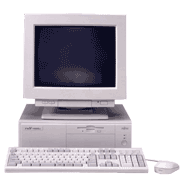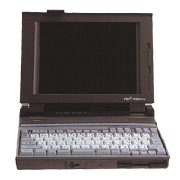In October 1993 Fujitsu announced the new FMV series of computers with an AT-compatible architecture.*1 Fujitsu had been known for its FM R series computers, which had a proprietary architecture, but after this announcement the AT-compatible FMV series became the company’s main brand.
- *1. AT-compatible architecture: A computer architecture that began with IBM’s PC/AT computers in 1984. It became a de facto standard in the computer industry and was adopted worldwide because it was an open architecture. Computers that were built around this architecture were called AT-compatible machines.
The initial October 1993 announcement introduced a first wave of three desktop models — FMV-425D, FMV-433D, and FMV-466D — and three notebook models — FMV-425N, FMV-425N/T1, and FMV-433N/T2. The first FMV models were primarily used for business applications, but Fujitsu added the FMV DESKPOWER series in 1994 that was specifically tailored for consumer use, thereby creating a model lineup that covered both business and consumer needs. The FM R series models were sold concurrently for a time, but they were eventually discontinued.
At the time of Fujitsu’s move, AT-compatible machines were beginning to make inroads in the Japanese market as affordably priced computers because Japanese language processing could be done natively in the operating system. Most AT-compatible manufacturers, however, were new entrants to the market. Because of this and because of enterprise users’ concerns about after-sales support, computers with proprietary architectures still dominated the domestic market. Thus, it wasn’t until Fujitsu — a major domestic computer player — brought out the AT-compatible FMV series that AT compatibles truly took off.
| Model name | FMV-425D | FMV-433D | FMV-466D |
|---|---|---|---|
| Introduced | October 1993 | ||
| CPU | i486SX 25MHz |
i486DX 33MHz |
i486DX2 66MHz |
| Upgradable with an OverDrive Processor*1 | |||
| Memory | 4MB | 4MB | 4MB |
| Hard disk drive | 0 / 170MB / 340MB | 0 / 170MB / 340MB | 0 / 170MB / 340MB |
| OS | Windows3.1, DOS/V | Windows3.1, DOS/V | Windows3.1, DOS/V |
| Other details |
|
||
| Model name | FMV-425N | FMV-425N/T1 | FMV-433N/T2 |
|---|---|---|---|
| Introduced | October 1993 | ||
| CPU | i486SX 25MHz |
i486DX 33MHz |
|
| Built-in screen | 9.4-inch STN, monochrome | 8.4-inch TFT, color | 10.4-inch TFT, color |
| Memory | 4MB | 4MB | 4MB |
| Hard disk drive | 0 / 85MB / 170MB | 0 / 85MB / 170MB | 170MB / 250MB |
| OS | Windows3.1, DOS/V | Windows3.1, DOS/V | Windows3.1, DOS/V |
| Other details |
|
||
- (*1) OverDrive Processors, sold separately, were an upgrade equivalent to a higher-performance or next-generation CPU.
- (*2) Energy Star: An international labeling system initiated to reduce the power consumption of office automation products. Products that clear requirements set by the U.S. Environmental Protection Agency (EPA) are permitted to use the Energy Star logo. The Energy Star program was launched in Japan in 1995, but these models participated in the U.S. program.
- (*3) ISA: Industry Standard Architecture. The ISA bus is an IEEE standard bus based on the specifications of IBM’s PC/AT data transfer bus.
- (*4) The VL bus is a data transfer bus for graphics accelerator cards. The standard was set by the Video Electronics Standards Association (VESA), a U.S. industry group of computer peripheral manufacturers.
- (*5) OADG: PC Open Architecture Developers’ Group. An industry group set up to promote AT-compatible machines in Japan. The group consisted of many computer manufacturers, peripheral-device manufacturers, and software developers. Today’s computer keyboards are still largely based on the OADG standard keyboard layout.



